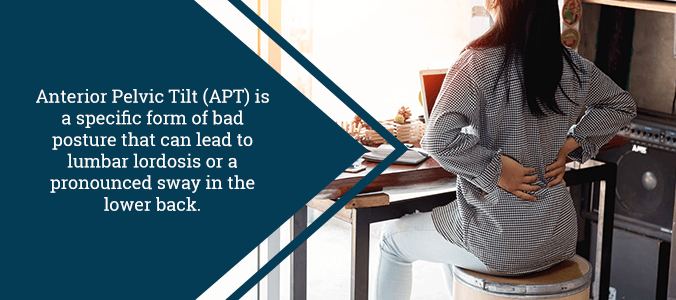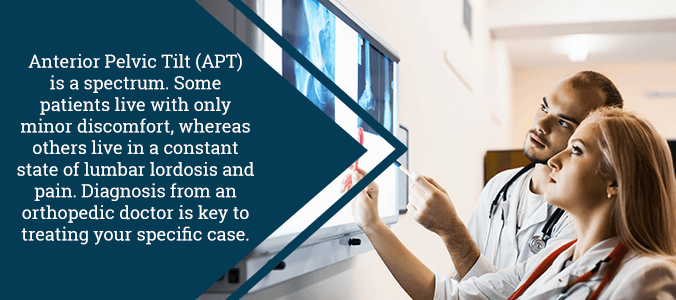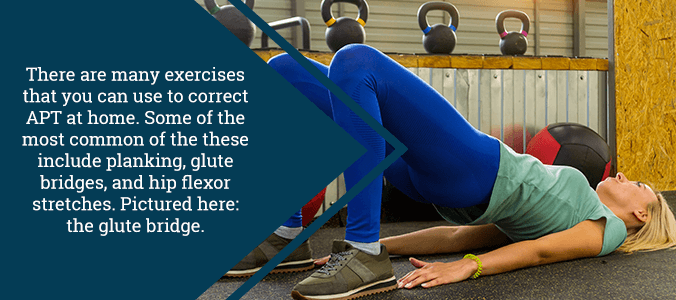How to Correct Anterior Pelvic Tilt (& Lumbar Lordosis)
Bad posture affects millions of people each year, and the number is only rising. Anterior pelvic tilt (APT) is one of the most common manifestations of bad posture. In more severe cases, APT causes pain, as well as decreased functionality. Luckily, there are ways to remedy APT through corrective exercises that will help you return to your normal activity level.
Pelvic tilt may occur in different directions. The pelvis could lean toward the anterior (front) or posterior (back) plane. The former, however, is the most common form of pelvic tilt. APT causes the pelvis to tilt forward, pushing the buttocks out and forcing the lumbar spine to arch (hyperlordosis). This postural condition occurs in people who engage in a multitude of different lifestyles, regardless of whether you are an athlete or not. Needless to say, the reach of APT is far and wide.
Most of the time, however, people are not aware that they have APT. This is because a majority of individuals with APT are not aware of what a normally aligned pelvis feels like. Secondly, pain with APT often occurs in the lumbar spine and not the hips. As a result, patients often mistake this condition for a disorder more closely linked to the hips.

Anatomy of Anterior Pelvic Tilt (APT)
The pelvic area is surrounded by a series of muscles that are almost always stimulated when we exercise. The pelvic tilt from APT causes lordotic curves, which in turn stretches these abdominal muscles. Over time, this postural state causes the individual to have weak core muscles. More specifically, it affects the transverse abdominals and the obliques. Additionally, other muscles such as the glutes and hamstrings will suffer from the same problem. When these muscle groups stretch out like this, it results in a lack of muscular tension. Lax muscles, therefore, are often both a cause and effect of this condition.
As mentioned earlier, APT often causes lumbar back pain. This occurs because of the way in which the muscles are affected by this abnormal postural position. The hip flexors, erector spinae, and lower back extensors all play a role in supporting the tilted pelvis. Additional strain is placed upon these muscle groups when lordotic curves come into play (and, APT often goes hand in hand with hyperlordosis). Naturally, this leads to unpleasant symptoms in the lumbar spine and load-bearing joints such as the knees and ankles.
The Anterior Pelvic Tilt (APT) Spectrum
As with most medical conditions, APT comes in varying degrees of severity. Some forms of the condition cause pain and may alter the patient’s functionality. On the other hand, there are also cases where minor exercise adaptations are all that one needs for treatment.
APT is a fixable problem, but some patients may have to work much harder than others for a return to normalcy. Ultimately, the difficulty will depend on the patient’s goals, ability level, and the severity of the postural disturbance. Most programs tailored to addressing this problem focus on t-spine extension, self-myofascial techniques, and other stretching and strengthening exercises. All of these elements work together to help restore the patient to a state of normalcy.
Some patients find that APT only affects them moderately while standing, whereas others live in a constant state of lumbar lordosis. The latter, of course, is more serious, because no matter what the patient is doing, his or her pelvis is always tilted forward. Whether he or she is sitting, standing, or performing any other activity–it does not matter. These are the clients who need to pay the most attention to correcting their APT.

Anterior Pelvic Tilt (APT) Assessment
Before the patient addresses APT, he or she should first ask themselves a series of questions. The goal is to understand why the postural balance exists in the first place. Does the client live a sedentary lifestyle? If so, APT may develop because of the patient’s inactivity, muscular imbalance, and poor posture control. Then there is the other side of the spectrum: what if the patient is athletic? More specifically, avid lifters develop APT through the repetitive motions that they perform in their everyday exercises. Repetitive squatting and lunging put a lot of stress on the pelvic area and its surrounding muscles. More often than not, these patterns translate into everyday postures without the athlete even realizing it.
Thankfully, most clients of this nature will achieve good results from corrective APT exercises. It is important to note that, although APT occurs in a wide range of people, it is not guaranteed to occur in all sedentary individuals or athletes. For instance, some athletes are able to perform at a world-class level with no lower back pain or postural imbalances. In these patients, it is obviously best to leave things as they are–don’t fix what isn’t broken. Of course, it may not hurt to do some corrective exercises here and there as a preventative measure just in case.
Exercises to Correct Anterior Pelvic Tilt (APT)
There are plenty of corrective exercises that can address APT and its accompanying symptoms. Ideally, a trainer should define the patient’s program with 6 goals in mind:
- Stimulate and stretch the lumbar spine
- Activate and loosen the thoracic spine
- Increase flexibility in the anterior hip
- Strengthen the patient’s core muscles
- Reinforce the glutes
- Enhance hamstring strength
You can achieve these goals using a program that contains a healthy dose of stretching and strengthening movements. It should be noted, however, that if the client already has an exercise regimen, they do not need to abandon it for this specific program. Instead, the patient should think of this program as a supplement to what they already do.
Specific exercises for APT include:
Plank
This exercise strengthens the glutes as well as the anterior core muscles. For this exercise, the patient should first squeeze their feet together while clenching their glutes. It is important to keep the hands apart and pull in opposite directions, as this helps with lateral muscle tension. Next, the patient will flex their abdominal muscles upward and inward, whilst keeping a neutral position in the cervical spine.
The most important aspect of this exercise is not how long the client maintains it, but how well they perform the plank. If done properly, most people find it difficult to hold the position for more than ten seconds.
Glute Bridge
This exercise is the gold standard for correcting APT. To perform this exercise, the client must first lie face up on the floor with knees bent and feet flat on the floor. Additionally, the arms should be at the side with the palms facing downward. Next, the client lifts his or her hips off the ground, while the knees, hips, and shoulders, remain in a straight line. It is important to squeeze the glutes hard during this stage, as well as keep the abs drawn in. This prevents injury. Hold this position for a couple of seconds and then repeat the exercise.
Again, it is most important that the client is performing the bridge properly. Things such as how high the client bridges or how long he or she holds the position are not important.

Hip Flexor Stretches
There are multiple ways to stretch the hip flexors, but this section will focus on the standing stretch. The standing stretch is simple. First, the client starts with feet apart (hip-width) and toes forward. The next step is to bend the right knee while bringing the right heel up toward the glutes. After that, hold the foot and gently pull until the knee points toward the floor. Once in this position, hold for 30 seconds and then repeat the exercise on the other side of the body.
If the client has trouble balancing, it is fine for them to hold on to something with their unused hand for support. This exercise is great for addressing issues such as muscle tightness and spasms.
If you have lower back pain, please contact Dr. Jason E. Lowenstein at (855) 220-5966. Dr. Lowenstein is an industry-leading expert in both minimally invasive surgical procedures and spinal deformities. He will make sure that you receive a treatment plan for your lordosis that serves your specific needs.
